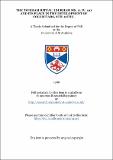Files in this item
The 'Durham Ritual' (Durham Ms. A. IV. 19) and its place in the development of collectars, 8th-12th centuries
Item metadata
| dc.contributor.advisor | Bullough, Donald A. | |
| dc.contributor.author | Corrêa, Alicia Michelle Harting | |
| dc.coverage.spatial | iv, 434 p. | en_US |
| dc.date.accessioned | 2018-06-15T09:57:06Z | |
| dc.date.available | 2018-06-15T09:57:06Z | |
| dc.date.issued | 1988-07 | |
| dc.identifier.uri | https://hdl.handle.net/10023/14103 | |
| dc.description.abstract | Few liturgical historians are aware that a book of collects for the Divine Offices formed part of the service-books owned by a monk or priest during the late eighth to the end of the twelfth century. Conciliar decrees and liturgical rules remain silent about its function and development. On account of the paucity of information from the non-liturgical evidence, one can only formulate an idea about the collectar from the surviving manuscripts. The Durham Cathedral Library, Ms.A.IV.19, misnamed the 'Durham Ritual', is the earliest collectar to have survived in England. It has been tentatively dated to the early tenth century, written in the south of England from an unknown exemplar. At least five continental collectars pre-date the Durham Collectar. This number increases substantially in the eleventh century, when the Leofric Collectar and Wulfstan Portiforium, the better-known English collectars, were written. By the twelfth century, the collectar is still used; but its association is so intertwined with other office material that it is but a small step away from the breviary. In an effort to place the Durham Collectar within the development of collectars, the surviving manuscripts prior to the twelfth century have been examined. No standard collectar ever materialized. The 'pure collectar' of the eighth century extracted only the extraneous prayers from the mass-set of a single sacramentary. By the ninth century, some of the more important mass prayers were introduced, in particuliar, the collecta. Both Gelasian and Gregorian prayers were extracted, possibly reflecting the more complex structure of the sacramentary source. At the turn of the century, the capitula, or short chapter readings from the Bible, were also added. The Durham Collectar represents this primitive stage, before the prayers and chapters were divided into offices. The exemplar of the DC adhered closely to its sacramentary source. Textual analysis of the prayers, in particular those for All Saints and St. Martin, among others, indicate that this sacramentary lay very close to Tours and the compositions of Alcuin. These continental affiliations and its primitive organization place the DC at odds with the tenth- and eleventh-century English service-books. This may explain the treatment it received in England. It was sent northwards soon after it was hastily copied in southern England by a scribe who was not trained in a Winchester scriptorium. At Chester-le-Street, members of the Cuthbert community added other office material and educational texts. By c.970, it was glossed by Provost Aldred, the famous glossator of the Lindisfarne Gospels. | en_US |
| dc.language.iso | en | en_US |
| dc.publisher | University of St Andrews | |
| dc.subject.lcc | BX1999.A3D9C7 | en |
| dc.subject.lcsh | Catholic Church. Durham collectar | en |
| dc.title | The 'Durham Ritual' (Durham Ms. A. IV. 19) and its place in the development of collectars, 8th-12th centuries | en_US |
| dc.type | Thesis | en_US |
| dc.type.qualificationlevel | Doctoral | en_US |
| dc.type.qualificationname | PhD Doctor of Philosophy | en_US |
| dc.publisher.institution | The University of St Andrews | en_US |
This item appears in the following Collection(s)
Items in the St Andrews Research Repository are protected by copyright, with all rights reserved, unless otherwise indicated.

